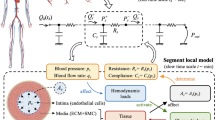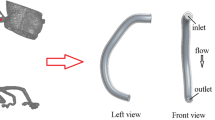Abstract
We developed and validated a new, more accurate, and easily applied method for calculating the parameters of the three-element Windkessel to quantitate arterial properties and to investigate ventriculoarterial coupling. This method is based on integrating the governing differential equation of the three-element Windkessel and solving for arterial compliance. It accounts for the interaction between characteristic impedance and compliance, an important phenomenon that has been ignored by previously implemented methods. The new integral method was compared with four previously published methods as well as a new independent linear least-squares analysis, using ascending aortic micromanometric and volumetric flow measurements from eight dogs. The parameters calculated by the new integral method were found to be significantly different from those obtained by the previous methods but did not differ significantly from maximum likelihood estimators obtained by a linear leastsquares approach. To assess the accuracy of parameter estimation, pressure and flow waveforms were reconstructed in the time domain by numerically solving the governing differential equation of the three-element Windkessel model. Standard deviations of reconstructed waveforms from the experimental ensemble-averaged waveforms, which solely reflect the relative accuracy of the Windkessel parameters given by the various methods, were calculated. The new integral method invariably yielded the smallest error. These results demonstrate the improved accuracy of our new integral method in estimating arterial parameters of the three-element Windkessel.
Similar content being viewed by others
References
Burkhoff, D.; Alexander, J. Jr.; Schipke, J. Assessment of Windkessel as a model of aortic input impedance. Am. J. Physiol. 255:H742-H753; 1988.
Campbell, K.B.; Lee, L.C.; Frasch, H.F.: Noordergraaf, A. Pulse reflection sites and effective length of the arterial system. Am. J. Physiol. 256:H1684-H1689; 1989.
Dujardin, J.P.L.; Stone, D.N.: Characteristic impedance of the proximal aorta determined in the time and frequency domain: a comparison. Med. Biol. Eng. Comp. 19:565–568; 1981.
Finkelstein, S.M.; Collins, V.R.. Vascular hemodynamic impedance measurement. Prog. Cardiovasc. Dis. 24:401–418; 1982.
Frank, O.. Die Grundform des arteriellen pulses. Z. Biol. 37:483–526; 1899.
Laskey, W.K.; Parker, H.G.; Ferrari, V.A.; Kussmaul, W.G.; Noordergraaf, A. Estimation of total systemic arterial compliance in humans. J. Appl. Physiol. 69:112–119; 1990.
Li, J.K.J. Time domain resolution of forward and reflected waves in the aorta. IEEE Trans. Biomed. Eng. 33:783–785; 1986.
Lucas, C.L.; Wilcox, B.R.; Ha, B.; Henry, G.W. Comparison of time domain algorithms for estimating aortic characteristic impedance in humans. IEEE Trans. Biomed. Eng. 35:62–68; 1988.
McDonald, D.A. Blood flow in arteries. Baltimore: Williams & Wilkins; 1974: pp. 315–322.
Milnor, W.R. Hemodynamics, ed 2. Baltimore: Williams & Wilkins; 1989: pp. 170–179.
Murgo, J.P.; Westerhof, N.; Giolma, J.P.; Altobelli, S.A. Aortic input impedance in normal man: relationship to pressure wave forms. Circulation 62:105–116; 1980.
Murgo, J.P.; Westerhof, N.; Giolma, J.P.; Altobelli, S.A. Manipulation of ascending aortic pressure and flow wave reflections with the Valsalva maneuver: relationship to input impedance. Circulation 63:122–132; 1981.
Nichols, W.W.; O'Rourke, M.F.; Avolio, A.P.; Yaginuma, T.; Murgo, J.P.; Pepine, C.J.; Conti, C.R. Effects of age on ventriculo-vascular coupling. Am. J. Cardiol. 55:1179–1184; 1985.
O'Rourke, M.F. Vascular impedance in studies of arterial and cardiac function. Physiol. Rev. 62:570–623; 1982.
Pasipoularides, A. Clinical assessment of ventricular ejection dynamics with and without outflow obstruction. J. Am. Coll. Cardiol. 15:859–882; 1990.
Pasipoularides, A. Cardiac mechanics: basic and clinical contemporary research. Ann. Biomed. Eng. 20:3–17; 1992.
Pasipoularides, A.; Murgo, J.P.; Miller, J.W.; Craig, W.E. Nonobstructive left ventricular ejection pressure gradients in man. Circ. Res. 61:220–227; 1987.
Pepine, C.J.; Nichols, W.W.; Conti, C.R. Aortic input impedance in heart failure. Circulation 58:460–465; 1978.
Press, W.H.; Flannery, B.P.; Teukolsky, S.A.; Vetterling, W.T. Numerical recipes. New York: Cambridge University Press; 1986: pp. 509–520, 547–554.
Randall, O.S.; Esler, M.D.; Calfee, R.V.; Bulloch, G.F.; Maisel A.S.; Culp B. Arterial compliance in hypertension. Aust. NZJ. Med. 6(suppl):49–59; 1976.
Shim, Y.; Hampton, T.G.; Straley, C.A.; Harrison, J.K.; Spero, L.A.; Bashore, T.M.; Pasipoularides, A.D. Ejection load changes in aortic stenosis: observations made after balloon aortic valvuloplasty. Circ. Res. 71:1174–1184; 1992.
Shoukas, A.A.; Sagawa, K. Control of total systemic vascular capacity by the carotid sinus baroreceptor reflex. Circ. Res. 33:22–32; 1973.
Sunagawa, K.; Burkhoff, D.; Lim, K.O.; Sagawa, K. Impedance loading servo pump system for excised canine ventricle. Am. J. Physiol. 243:H346-H350; 1982.
Toorop, G.P.; Westerhof, N.; Elzinga, G. Beat-to-beat estimation of peripheral resistance and arterial compliance during pressure transients. Am. J. Physiol. 252:H1275-H1283; 1987.
Toy, S.M.; Melbin, J.; Noordergraaf, A. Reduced models of arterial systems. IEEE Trans. Biomed. Eng. 32:172–174; 1985.
Westerhof, N.; Bosman, F.; De Vries, C.J.; Noordergraaf, A. Analog studies of the human systemic arterial tree. J. Biomech. 2:121–143; 1969.
Westerhof, N.; Elzinga, G.; Sipkema, P. An artificial arterial system for pumping hearts. J. Appl. Physiol. 31:776–781; 1971.
Westerhof, N.; Noordergraaf, A. Arterial viscoelasticity: a generalized model. J. Biomech. 3:357–379; 1970.
Westerhof, N.; Sipkema, P.; Van den Bos, G.C.; Elzinga, G. Forward and backward waves in the arterial system. Cardiovasc. Res. 6:648–656; 1972.
Yin, F.C.P.; Zhaorong, L.; Brin, K.P. Estimation of arterial compliance. In: Yin, F.C.P., ed. Ventricular/vascular coupling. New York: Springer-Verlag; 1987: pp. 384–398.
Author information
Authors and Affiliations
Rights and permissions
About this article
Cite this article
Shim, Y., Pasipoularides, A., Straley, C.A. et al. Arterial windkessel parameter estimation: A new time-domain method. Ann Biomed Eng 22, 66–77 (1994). https://doi.org/10.1007/BF02368223
Received:
Accepted:
Issue Date:
DOI: https://doi.org/10.1007/BF02368223




